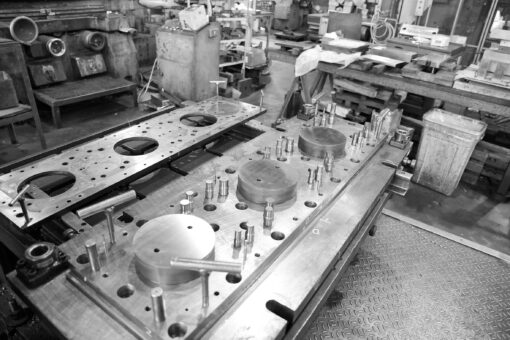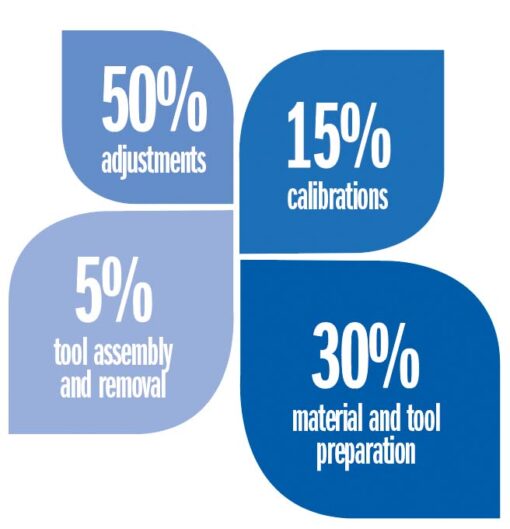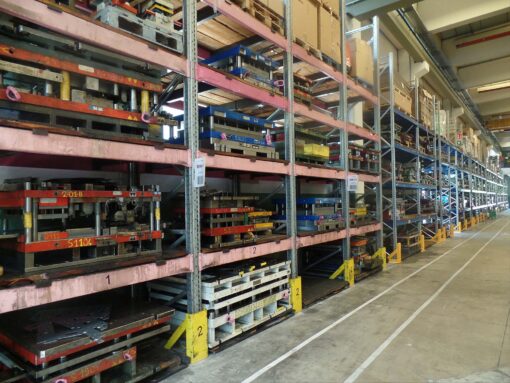Among activities that do not generate value, which would thus be beneficial to reduce to a minimum, the machine set-up stands out. Smed is an excellent approach to optimize and make set-up times more efficient

Any activity that the customer is not interested in paying is wasteful
In all manufacturing sectors, set-up times and costs have always been a problem for entrepreneurs, planners and operators. Changing production, settings and tools generates production stoppages, physical strain and stress. Although some companies still believe that set-up should not be rationalized because it is a paid activity, it is necessary to devote time and investment to the study of set-ups, in order to avoid customer migration to suppliers capable of following the constant batch reduction trend with a consequent increase in the number of set-ups. As lean manufacturing shows, any activity that the customer is not interested in paying for is a waste. Even those who have never followed the philosophy of lean manufacturing have always considered the set-up to be useless, but most of the time the solution implemented has managed to eliminate or reduce the execution time.
Standard solutions
The most classic solution is to invest on planning staff and software able to optimize this step, a solution that brings advantages, but is often not supported by other tools that can allow simplification and greater flexibility of this organizational phase. The planner tries to improve machine performance by reducing the number of set-ups, mass-producing similar products and sheet metal of the same thickness, but this “castle” is shattered by the blows of changing customer demands, faster delivery, or products whose assembly requires different materials. Thus, a duel between the planner and the sales department is triggered, with the latter trying to triumph for the survival of the company to the detriment of the former’s motivations. So many planners are stressed, humiliated and sometimes fired…
The attempt to plan and condition the choices of customers having been in vain, an attempt is then made to increase sales batches. The strategy is to push customers to buy more pieces by aggregating annual consumption, but is this really beneficial for our customer? We would gladly do it upon request of on our our suppliers, but what if we weren’t so sure we could sell the parts, if we couldn’t pay for them right away or had the storage space? Wouldn’t we all choose the other supplier who can only do what we have requested in acceptable time and cost? All these questions point to an obvious answer, which companies often do not want, or perhaps cannot accept by not finding a different and satisfactory solution.

Reduce set-up times
Another solution is to create teams of set-up personnel, to work on operators’ expertise, and to stabilize and reduce set-up times. Completely dedicated figures are created which are often very expensive, and sometimes a hindrance because they are numerically limited and devoid of ubiquity. While these talents are working, operators remain completely immobile, are employed in often unnecessary activities, their sense of responsibility is limited, and their motivation is reduced. Everyone must be trained, but often it is too difficult for some operators to learn. Shingeo Shingo, in the 50s, said: “Many companies have implemented policies to increase employees’ skills, few have implemented strategies that reduce the level of knowledge required to carry out the set-up”. Planning well, trying to merge batches and create capable set-up personnel are not solutions to be excluded, but are we sure that they are really the starting point?
Single minute exchange die
A lean manufacturing tool, the SMED, is dedicated to reducing set-up time. The SMED, invented by Shingo, is an acronym (single minute exchange die) that means mold change in less than 10 minutes and it is a methodology that in its simplicity can obtain great results, useful for making the planning work and for balancing the accounts.
The first step is to define what the set-up time really is, when does it start and when does it end?
To get real benefits and stabilize planning, it is necessary to understand that set-up constitutes all the time between the last piece of a production batch and the first piece of the next batch of a different product. It would be reductive and inefficient to consider only the time of tool change, as there are many activities to finish the previous batch, to search for documents and information, to pick up materials, and to wait. The statistics support what has been written and highlight that the set-up time is presented as percentages as follows:
- 50% adjustments
- 30% material and tool preparation
- 15% calibrations
- 5% tool assembly and removal
An overview of the current situation
Have you ever stopped to observe what really happens in the production departments?
Unfortunately, in the traditional view the set-up time is an unchangeable datum, I often hear myself saying: it’s impossible to improve. Very often the real time of this phase is not known specifically, but simply assumed based on long-term experience in the field. The lean production vision considers the set-up a problem that causes a decrease in flexibility and damage to the customer who can no longer make predictions and buy large batches as in the past. The objective of this path is to be able to reduce time and costs, follow the customers’ requests and produce only what is necessary, not falling into the temptation of producing large batches.
To achieve the result it is necessary: to simplify operations. As already described, it is necessary to make the set-up easier and therefore allow several operators to carry out the operations autonomously. In doing so, expectations will be eliminated, efforts will be reduced, and operators will be autonomous.
Prepare what is necessary in advance: a careful analysis will allow you to understand that the search for people, materials, documents, and tools occupies a large part of the set-ups in the world of sheet metal. Having a well-organized company and careful management of the next job order will keep both customers and finances happy.
Making the duration of the set-up predictable: the real difficulty for the planner is to know how long the scheduled phases will really last; reasoning on average does not help if I do not reduce the variability of the processes. Structuring a method always means using the same time, with good peace of mind in the planning department.
Make fewer adjustments: previous statistics show how important it is not to stop at analyzing simply the tool change, but to help operators get production up and running quickly.
Thanks to SMED, time saved and necessary investments are as follows:
- 30% time reduction at no cost with organizational interventions
- 20% time reduction in investments with six-month pay back
- Reduction of time by 20% investments with n years pay back
How to apply SMED
Going into detail of the method, the SMED initially provides for the definition of the set-up phase to be analyzed that can allow the development of an ambitious but extremely feasible project. Production has been organized in order to be able to carry out a test in realistic situations, i.e. the normal conditions in which the operator has to work, and it is advisable to make a video that then allows you to proceed with the analysis, without further hindering the production, but above all that allows you to detect all the components of the phase and the timing of each of them. The video is crucial to the success of the method, but sometimes it has difficulties. The first is related to tools; do not worry, you do not need high definition and just a simple smart phone, the important thing will be to never stop recording, and eventually follow the operators in the movements within the company to be able to really report everything that happens in the time frame considered. The second is to persuade the operators to grant the release and to act as stakeholders and the approach with which the project will have to be managed is crucial. The SMED works on the organization and not on the judgment of the staff involved. Be careful not to fall into the temptation of criticizing those who are reprimanded, but thank them for their courage and willingness, in case you make a mistake. Try to understand why it is easy to make a mistake and help them to prevent it from happening again in the future. Without this mentality you will never find more people available in the workshop!
After making the video you need to create an analysis team, the advice is to enter:
- Department manager who will then have to make the new procedures operational
- Time and method expert who can help in the method of analysis
- Set-Up operator who will be able to give new technical solutions to support the operators
- Quality officer who will carry out the new procedures and disseminate them in the company
The recorded operator will explain what happens in the video, what difficulties they have near the machine, but above all that they will feel helped and not judged. Do not forget that good management will motivate the operator to return to production with a nice message for colleagues: we can work with less difficulty and more results if we get out of the habit.

The basic goal of the SMED is to carry out mold change operations in less than 10 minutes
Step 1
The team watching the video will have to identify all the operations that are normally performed to prepare the machine for the next processing. In practice, everything that happens will have to be divided into small operations, indicating the time for each of them.
Step 2
The team will have to separate the operations that have to be carried out with the machine stopped (internal IED) from those that can be carried out with the machine in motion (external OED). The second step is therefore to organize activities that can be carried out before the end of the previous batch or after the end of the batch being processed, such as document management, handling of blanks and workpieces, tool preparation and storage.
Step 3
After outsourcing as much as possible, the team must focus on hindrances to the machine by rationalizing the operations that must be carried out with the machine stopped (internal IED). Determining at this stage are the skills of technicians and suppliers who can help to reduce and simplify the necessary activities, to introduce a standardization of the necessary tools and to include auxiliary equipment. Be careful not to underestimate small wastage, they are the most easily solvable and are often repeated thousands of times, weighing down on the company at the end of the year.
Step 4
Once the internal phases have been reduced, the team must work to rationalize the operations that can be carried out with the machine being processed (external OED). This phase is important in avoiding that the advantage gained on the machine is obtained simply by moving waste that was present in the set-up to other figures. In this case, the line-by-line analysis will allow many improvement projects to be implemented.
Standardize results
At the end of the process it is necessary to standardize the operations and create a shared procedure. Operators need to understand the importance of reducing set-up time and of using the same time to ensure delivery and cost-efficiency. Another essential activity is to provide, depending on the workload, alternative procedures. For example, in the event that a department is overloaded, an attempt will be made to outsource all the phases that can be carried out by machine in movements, and vice versa; in of the event of very little work, operators will also be able to dedicate themselves to external phases.



